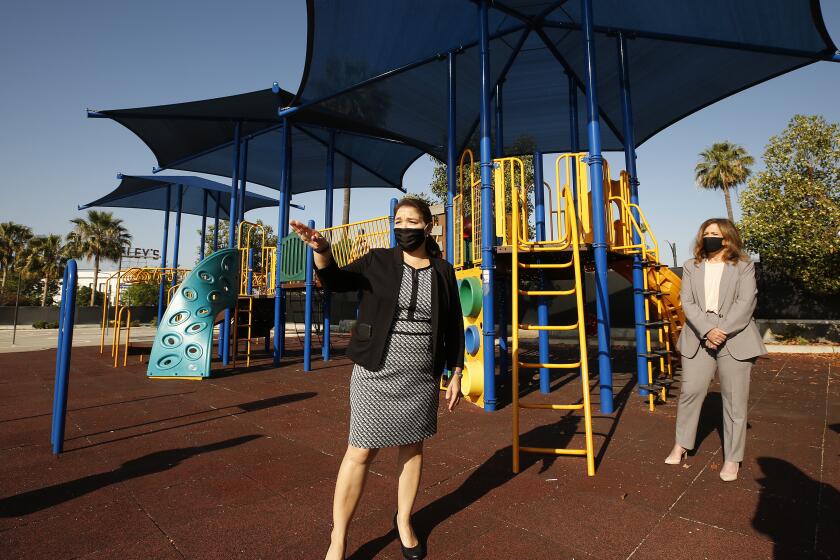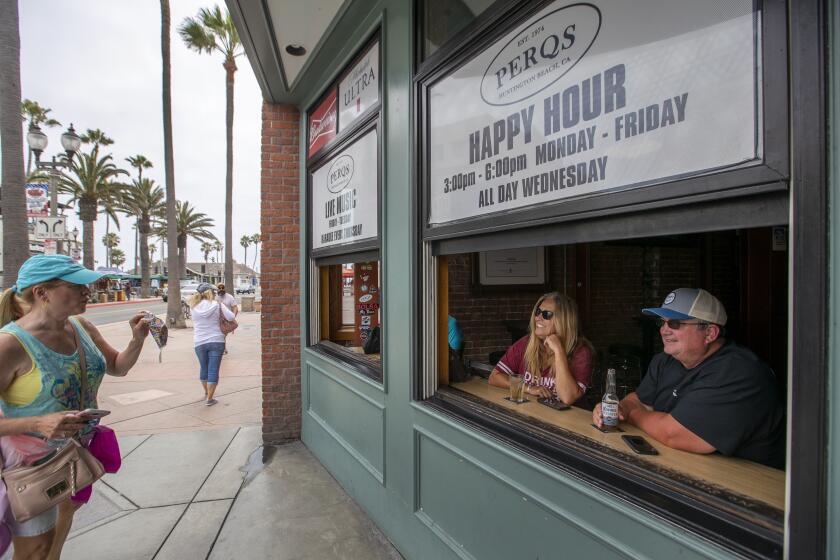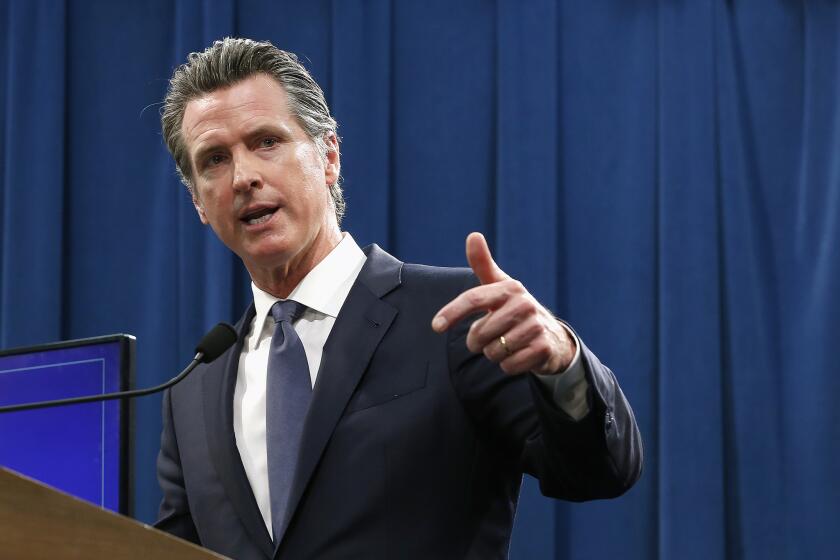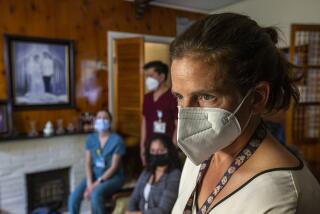California sets record for most coronavirus cases in a single day
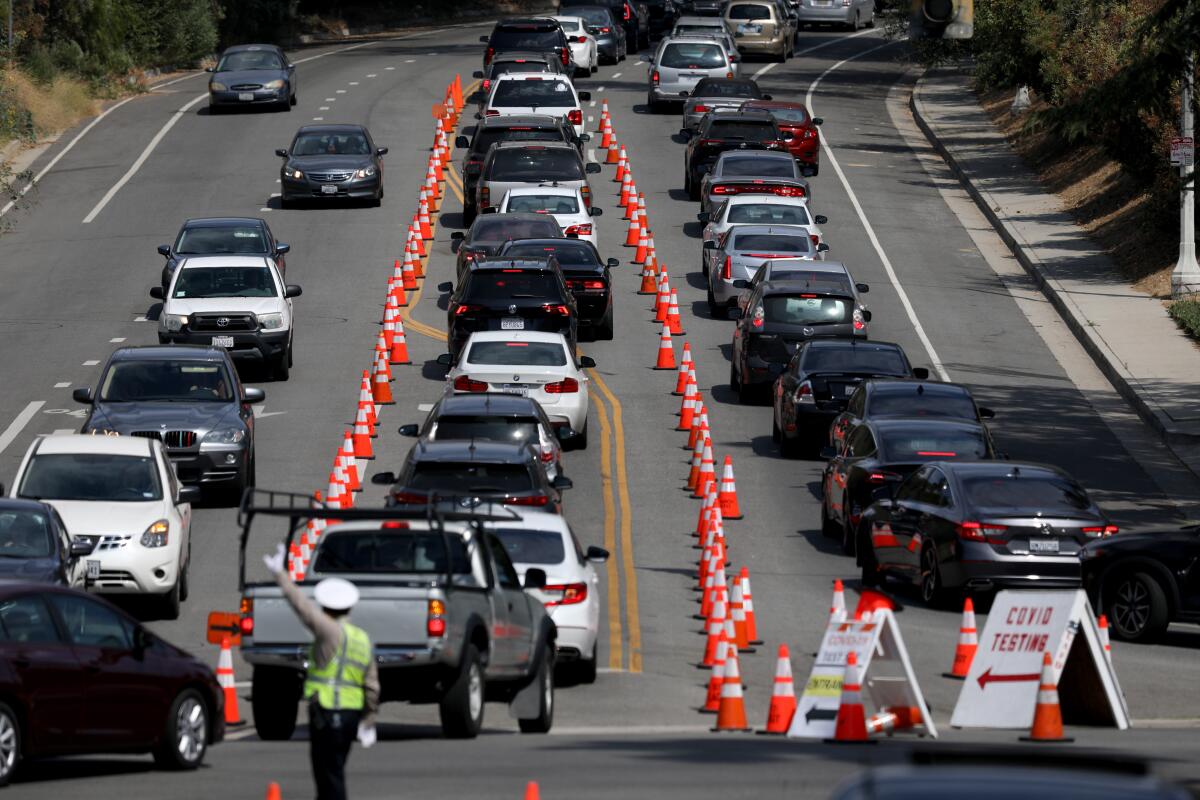
The coronavirus outbreak continued to worsen in California this week, with 9,500 infections recorded on Tuesday — the most new cases reported in a single day since the pandemic began — and triple-digit fatalities that sent the statewide death toll past 6,500.
California cases are on pace to double every 24.8 days, a number that is used by experts to measure how quickly the virus is spreading. As of Wednesday afternoon, the state had 284,691 coronavirus cases.
Over the last week, there have been an average of 7,403 new coronavirus infections and 69.6 new deaths per day, according to data from The Times’ tracker. With cases continuing to climb and hospitalization numbers increasing, counties across the state have been forced to roll back business reopenings in an effort to stem the spread of the virus.
On Wednesday, Gov. Gavin Newsom added Napa, Yolo and San Benito counties to the state’s list of counties being monitored for their rising case counts and increased hospitalizations. If the counties remain on the list for three or more consecutive days, the state will require them to close bars and indoor dining in restaurants, along with other indoor business operations, for at least three weeks. There are now 26 of California’s 58 counties on the list.
While San Francisco has not appeared on the watch list, officials this week opted to delay loosening restrictions on businesses, including indoor dining at restaurants, which were scheduled to resume next week. The city previously had suspended the reopening of hair salons, zoos, museums and outdoor bars.
San Francisco County had reported 4,020 recorded cases of the coronavirus and 50 deaths as of Wednesday morning.
“We know the pause on reopening is disappointing, but we cannot risk letting the virus get out of control,” San Francisco Mayor London Breed said. “We all need to do our part by wearing face coverings, keeping your distance from others, and getting tested so we can get to a place where we can safely resume reopening.”
Public and private schools must prepare for students to continue learning remotely, L.A.County public health director tells superintendents.
L.A. County Public Health Director Barbara Ferrer said during a news conference Wednesday that people fed up with the stay-at-home order who have tried to return to a pre-pandemic way of life have contributed to the increased spread of the disease in Southern California. She said the county is at a “critical juncture.”
“We’re entering a phase in which we’re seeing community spread and hospitalizations like we saw in late April and what we hoped would be the height of infection here in L.A. County. But as you’ve noted with us here this week, our cases are rising, the rate of infection is increasing and the number of hospitalizations are up,” she said. “Tragically, we do expect that more of our loved ones and neighbors may die of COVID-19 in the coming weeks with all of the increases we’re seeing with hospitalizations.
“Even though we miss the way it used to be, it’s still not safe or smart to visit with friends or family we don’t live with,” she added.
In Los Angeles County, which has the highest number of coronavirus cases and the most deaths in the state, officials confirmed 65 new coronavirus-related deaths and 2,496 additional cases Wednesday. A day earlier, officials reported 4,015 new cases, the highest number of infections the county has reported in a single day.
There have been 3,642 deaths and more than 123,000 cases countywide.
Health officials attributed Tuesday’s spike to a backlog of roughly 2,000 tests between July 2 and July 5. However, officials also noted that the seven-day average for the county’s daily positivity rate — those who test positive for the virus — has climbed to 11.6%. On Monday, it was just below 10%.
Access to testing has proved to be increasingly difficult in Los Angeles County, officials acknowledged Wednesday.
When the county began reopening businesses and protests erupted over the death of George Floyd, officials encouraged all residents to get tested for the virus, especially if they had been part of a protest or other large gathering. But in recent weeks, the county has not been able to meet the high demand for testing.
Now, rather than encouraging widespread testing, health officials are asking individuals to get tested only if they have symptoms, work in high-risk environments or have come into contact with a person with a known exposure. At the same time, officials are trying to add additional county-funded testing sites and increase appointments at existing sites to keep up with demand.
“This is the type of testing that is critical for public health purposes to be able to trace contacts and identify those who might transmit the virus to others,” said Dr. Christina Ghaly, L.A. County’s director of health services. “If you are exposed to someone with a known infection, then you need to quarantine yourself for 14 days. This is irrespective of whether or not you got a test and even if the test is negative.”
Orange County, which has the third-highest number of coronavirus cases in the state and the fourth most deaths, is also grappling with a surge in infections and hospitalizations in recent weeks.
Public health experts say wearing a mask can prevent the spread of COVID-19, but in Orange County many are still skeptical.
The county’s positivity rate, which health officials use to gauge whether case numbers are increasing because of more testing or because there’s more disease spreading within the community, was under 8% over a seven-day period in mid-May. As of Tuesday, the county had a case rate of 222 per 100,000 residents and a positive test rate of 14.2%, according to county health data.
The state has set a desired standard average of 25 positive cases per 100,000 over a 14-day period and a seven-day average positive test rate of 8%.
Health officials reported 1,010 new infections Tuesday, bringing the total number of cases to 18,892. Officials also reported three additional COVID-19 related deaths, putting the county’s death toll at 369.
The surge in new cases and the recent rollback of business reopenings prompted Supervisor Michelle Steel, who has repeatedly questioned the county health officer’s decision to mandate masks, to appeal to residents to wear a face covering.
“This is of the utmost importance to protect your health and the health of others, so that we can return back to normal as quickly as possible,” she said in a statement.
Gov. Gavin Newsom said Wednesday that the decision on reopening schools this fall will be made by local education and health officials and he does not feel pressured by statements from President Trump urging campuses to bring back students.
A new projection by the University of Washington’s Institute for Health Metrics and Evaluation said California could see a cumulative death toll of about 16,800 by Nov. 1 — an increase of more than 150% over the state’s current fatalities.
However, the projection notes that death numbers could be dramatically lower if 95% of California residents always wore a mask in public. In a universal masking scenario, California may see only about 12,000 deaths, the data show.
Newsom on Wednesday again urged Californians to take personal responsibility in slowing the spread of the virus by wearing masks, practicing physical distancing when possible and through frequent handwashing.
He noted that “hundreds of people across this country are dying on a daily basis because of this disease.”
“I hope all of us are sober about that and cognizant of the moment we’re in and the vulnerability that everyone has in this moment,” he said. He added that while conditions will eventually improve, it is not clear when.
“That’s determined by how we conduct ourselves and how we behave,” he said.
Times staff writer Rong-Gong Lin II contributed to this report.
More to Read
Sign up for Essential California
The most important California stories and recommendations in your inbox every morning.
You may occasionally receive promotional content from the Los Angeles Times.
